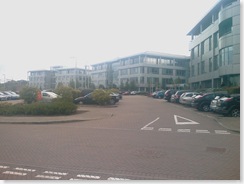Yesterday, as usually by some times, I went @ The Developers Group to the Reading Microsoft Campus Place (closer to London UK).
It's a very nice place (also if the weather is cloudly) and seems to be in Seattle with different buildings commited to different things (maybe seems to be in Seattle also because the weather conditions more or less are the same...)
In yesterday meeting the sessions were:
Overview of Silverlight 2 - Mike Ormond (Microsoft)
In this session we take a look at the sorts of web experiences that can be built with Silverlight 2.
We look at the different scenarios that Silverlight 2 enables and the core capabilities of the platform
for rich web experiences built on .NET. We also take an introductory look at the tooling and frameworks
that developers and designers have available to them for building Silverlight 2 applications.
Remarks by Corrado - Nothing to say. During the session some Silverlight demo have been presented and also some technical integration explanation about VS 2008 was been showed. My personal feeling is that all the effort on Silverlight development isn't on VS2008, XAML etc. but on Blend... You cannot create a "real world" application without Expression Blend and it's not an easy to learn tool... Well you must know the .Net Silverlight fundamental but the effort is on Expression!
Delphi 2009, What’s New? - Jon Harrison (Embarcadero)
Jon gives us an overview of the new features in Delphi 2009, including:
- new IDE features
- new and enhanced VCL components
- new DataSnap architecture
- new Unicode support
Remarks by Corrado - Nice platform. Seems to be in VS 2005 (not yet 2008). I've got 2 questions:
- If I was starting from scratch, without any Delphi skill, why should I choose Delphi against VS 2008? What's the added value??
- Is this platform tailored to migration projects? How it could enlarge Embarcadero market? Just with the integration with the DB tools??
Navigational Data Access in .NET - Joachim Duerr (Sybase)
Moving from ADO to ADO.NET means changing the view on how to access databases. The ADO.NET
data access model is disconnected and set based, which has advantages, but also disadvantages; all
records of the result set have to be transferred to the client in order to work with the data and
concurrency conflicts can happen when writing changes back to the database. This session shows
how you can develop in .NET but with connected record sets, with actual live data on the workstations
and the ability to lock records in the database to avoid concurrency conflicts.
Remarks by Corrado - The session showed how to create ISAM application leveraging "Advantage Database Server .Net Provider" that is built on ADO.Net extending the features to integrate with Sybase Advantage Server that basically is an ISAM-oriented (!) DBMS.
I agree with the limits of ADO.Net for ISAM oriented application but the limits arise because ADO.NET wasn't create for making ISAM applications...
I'd like to have some more architectural scenario where Sybase Advantage Server could be affordable. I can just think to small booking or crm applications where locking is very important.
For the upcoming sessions take a look at http://www.richplum.co.uk/
The next month (on the 15th october in Microsoft Cardinal Place closer to Victoria Station) I'll speak again aboutSharepoint:
Workflow Management
In this session we take a look at the off-the-shelf workflow features of Sharepoint, creating a quick and
easy “no-code” application with Sharepoint Designer and exploring the pros and cons of this approach.
Then we develop another sample application with Visual Studio 2008 and Windows Workflow
Foundation and bind it to a Sharepoint document list, exploring the potential of fine customization.
Windows Workflows Foundation is totally integrated with Sharepoint platform and very complex
application could be created leveraging the Sharepoint object model.




No comments:
Post a Comment